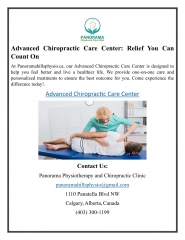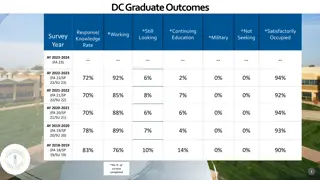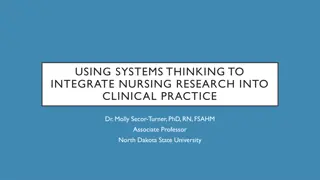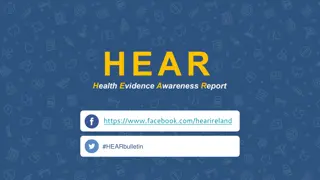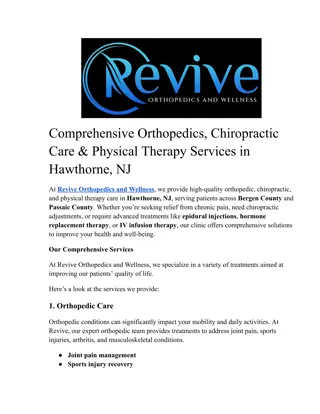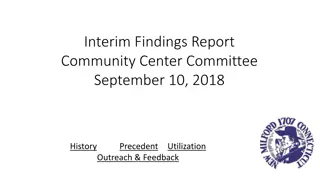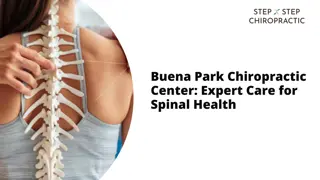Evidence-Based Chiropractic Practice within a Community Health Center
James J. Lehman, DC, MBA, FACO, shares insights on evidence-based chiropractic practice within a community health center setting. Discover the integration of chiropractic care into a clinical education model and the impact on community well-being. Gain valuable perspectives on the role of chiropractors in promoting health and wellness within a community healthcare framework.
Download Presentation

Please find below an Image/Link to download the presentation.
The content on the website is provided AS IS for your information and personal use only. It may not be sold, licensed, or shared on other websites without obtaining consent from the author.If you encounter any issues during the download, it is possible that the publisher has removed the file from their server.
You are allowed to download the files provided on this website for personal or commercial use, subject to the condition that they are used lawfully. All files are the property of their respective owners.
The content on the website is provided AS IS for your information and personal use only. It may not be sold, licensed, or shared on other websites without obtaining consent from the author.
E N D
Presentation Transcript
Evidence-Based Chiropractic Practice within a Community Health Center James J. Lehman, DC, MBA, FACO Director Community Health Clinical Education Associate Professor of Clinical Sciences University of Bridgeport School of Chiropractic
The passing of the Affordable Care Act has created an entirely new health care system that focuses on integrated, holistic, patient- centered and evidence- based primary care.
Health Care Reform This health care reform law highlights the need for more effective evaluation and management of acute and chronic pain.
Following a six-month pilot study, the Community Health Center, Inc. of Middletown, Connecticut accepted board-certified chiropractic specialists to the medical staff.
Community Health Center, Inc. (CHCI) Federally Qualified Health Center Patient- Centered Medical Home
Federally Qualified Health Center Health Resources and Services Association (HRSA) -supported health centers provide comprehensive, culturally competent, quality primary health care services to medically underserved communities and vulnerable populations.
Patient-Centered Medical Home The medical home is best described as a model or philosophy of primary care that is patient-centered, comprehensive, team- based, coordinated, accessible, and focused on quality and safety.
Patient-Centered Medical Home is not a final destination instead, it is a model for achieving primary care excellence so that care is received in the right place, at the right time, and in the manner that best suits a patient's needs.
Chiropractic Integration CHCI provides chiropractic services, chiropractic student rotations at nine primary care sites and the first chiropractic orthopedic residency with a subspecialty in neuromusculoskeletal medicine. This program was made possible by the Affordable Care Act, Section 2706, a non- discrimination statement.
Integration Chiropractic physicians were credentialed as members of the medical staff with evaluation and management privileges and specific chiropractic services.
Integration Full access and use of the electronic medical record
Integration Seamless referral process, which reduces stress for patients
Integration Improved level of cultural authority within a Federally Qualified Health Center and Patient-Centered Medical Home.
We have found that the integration of chiropractic services enabled our patients to experience less pain and promoted healthy living. Hopefully, other community health centers in Connecticut and across the country will use our model to reduce chronic pain and improve quality of life. Margaret Flinter, Ph.D. Senior Vice President and Clinical Director Community Health Center, Inc.
Chiropractic Integration Outcomes Increased referrals to chiropractic providers Reduced referrals to orthopedic surgeons Increased patient satisfaction Chronic pain patients experienced improved function Reduced use of opioids Allopathic provider satisfaction with chiropractic services
Economic Credentialing Expansion of Medicaid Benefits Value based payments for primary care Fee for service Salary Independent contractor
What does evidence- based practice mean to you?
Evidence-Based Practice Involves complex and conscientious decision- making, based not only on the available evidence, but also on patient characteristics, situations and preferences. It recognizes that care is individualized and ever changing and involves uncertainties and probabilities. McKibbon KA. Evidence-based practice. Bull Med Libr Assoc. 1998 Jul; 86(3):396-401.
Evidence-Based Medicine is the conscientious, explicit and judicious use of current best evidence in making decisions about the care of individual patients. The practice of evidence-based medicine means integrating individual clinical expertise with the best available external clinical evidence from systematic research. Sackett DL, Rosenberg WMC, Gray JAM, Haynes RB, Richardson WS. 1996. Evidence based medicine: what it is and what it isn t. BMJ 312: 71 2 [3].
Should Chiropractors Practice Evidence-Based Medicine?
Why Chiropractors Should Practice Evidence-Based Medicine Coordination of quality care Third party reimbursement Integration into primary care as a valuable service Become members of the health care team Scope of practice
National Prevention Strategy Published in June of 2011. It is proclaimed to be America s Plan for Better Health and Wellness. The strategy has been charged with moving America from a system of sick care to one based on wellness and prevention.
National Prevention Strategy Integrated healthcare, defined as a coordinated system that integrates evidence- based CAM (Complimentary and Integrative Medicine CIM) providers into healthcare delivery systems and primary care facilities within community health centers is expected to reduce pain and disability.
National Prevention Strategy Research will determine the effectiveness of chiropractic interventions and determine the best methods to integrate them into clinical environments to prevent disease and disability.
How Can Chiropractors Integrate a Coordinated Primary Care System?
Lovelace Health System Experience During 1991-1993, a three year experiment demonstrated that 91% of primary care physicians were willing to welcome a competent, chiropractor as a member of the medical staff and refer patients for chiropractic services. Pasternak DP, Lehman JJ, Smith HL, Piland NF. Can medicine and chiropractic practice side-by-side? Implications for healthcare delivery. Hosp Top 1999;77:8-17.
A Call to Revolutionize Chronic Pain Care in America: An Opportunity in Health Care Reform The Mayday Fund 2009
Most people in pain, including those with chronic symptoms, go to primary care providers or chiropractors seeking relief.
Chronic Pain Treatment -current systems of care do not adequately train or support internists, family physicians and pediatricians, the other health care providers who provide primary care in meeting the challenge of treating pain as a chronic illness.
Coordination of Chronic Pain Care It is an unusual patient who has access to coordinated interdisciplinary therapy for ongoing pain symptoms.
Chronic Pain Care Instead of receiving effective relief, patients with persistent pain often find themselves in an endless cycle, seeing multiple health care providers, including many specialists in areas other than pain, who are not prepared to respond effectively.
Chronic Pain Care Primary care providers often receive little training in the assessment and treatment of complex chronic pain conditions.
Chronic Pain Care They tend to work under conditions that permit little time with each patient and few options for specialist referrals.
What is missing in both acute and chronic pain care?
Identification of Painful Tissue is Missing History and symptoms Finger point by patient Palpation by clinician Posture Range of motion Provocative and palliative testing
Chronic Pain affects an estimated 70 million Americans and is a tragically overlooked public health problem. Health, United States, 2006. Available from: http://www.cdc.gov/nchs/data/hus/hus06.pdf.
Chronic Pain The burden of chronic pain is greater than that of diabetes, heart disease and cancer combined. American Academy of Pain Medicine [Internet]. Glenview, IL: AAPM; Accessed 2009 Sept 28. Available from: http://www.painmed.org/patient/facts.html
Chronic Pain Poorly assessed, unrelieved chronic pain can rob individuals and family members of a high-quality life, and it profoundly burdens society as a whole.
Chronic Pain A 1998 National Institutes of Health (NIH) report concluded that just the economic toll of chronic pain may be estimated at $100 billion a year in the United States. New Directions in Pain Research. NIH. Available from: http://grants.nih.gov/grants/guide/p a-files/PA-98-102.html.
Chronic Pain -patients with persistent pain often find themselves in an endless cycle, seeing multiple health care providers, including many specialists in areas other than pain, who are not prepared to respond effectively.
Chronic Pain They often endure repeated tests and inadequate or unproven treatments. This may include unnecessary surgeries, injections or procedures that have no long-term impact on comfort and function.
Chronic Pain Patients with chronic pain have more hospital admissions, longer hospital stays, and unnecessary trips to the emergency department. Such inefficient and even wasteful treatment for pain is contributing to the rapid rise in health care costs in the United States. American Pain Foundation [Internet]. Pain resource guide: getting the help you need. 2009 June [cited on 2009 July 30]; pg 2. Available from: http://www.painfoundation.org/learn/publications/files/PainResourceGuide2009.pdf.
Chronic Pain Historically, the health care system has failed to recognize chronic pain as a legitimate condition. However, it is clear that persistent pain is a complex illness that has many causes and affects every part of life, and in the process, exacts enormous social costs.
National Pain Strategy Chronic pain - Pain that occurs on at least half the days for six months or more. National Pain Strategy. Available from: https://iprcc.nih.gov/sites/default/files/ HHSNational_Pain_Strategy_508C.pdf.
Chronic Pain and High Impact Chronic Pain the 2016 National Pain Strategy called for more precise prevalence estimates of chronic pain and high-impact chronic pain (i.e., chronic pain that frequently limits life or work activities) to reliably establish the prevalence of chronic pain and aid in the development and implementation of population-wide pain interventions. DahlhamerJ, Lucas J, Zelaya, C, et al. Prevalence of Chronic Pain and High-Impact Chronic Pain Among Adults United States, 2016. MMWR Morb Mortal Wkly Rep 2018;67:1001 1006. DOI: http://dx.doi.org/10.15585/mmwr.mm6736a2


